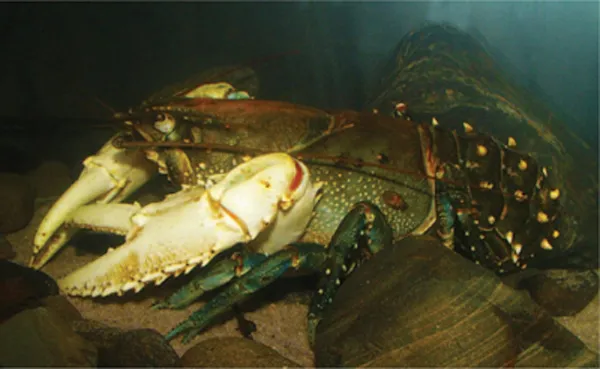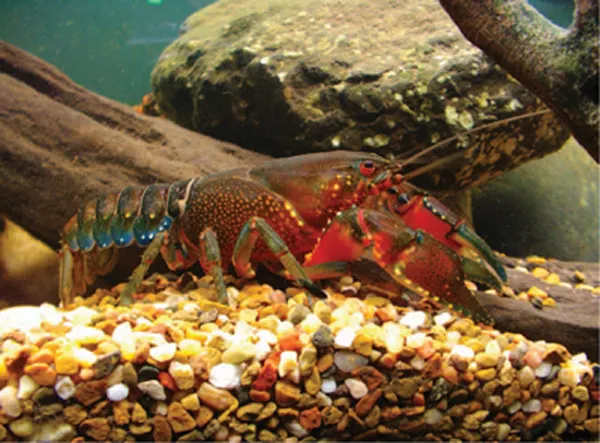![]()
SPECIES DESCRIPTIONS
The Murray cray
Euastacus armatus
(von Martens 1866)
The Murray cray or Murray lobster is Australia’s second largest crayfish species, growing to over 3 kg in weight. It is a true giant spiny crayfish with numerous large sharp spines, and is the largest of the Euastacus species. It has the widest distribution of all the Euastacus crays, occurring in New South Wales, Victoria and South Australia, and the second widest distribution of all crayfish in Australia, second only to the yabby Cherax destructor.
Murray River, New South Wales
Habitat/Activities: Euastacus armatus is a river/stream crayfish that, like most other Euastacus, prefers cool, flowing water. It prefers the faster-flowing water that is well oxygenated, and so is generally found in the main current flows away from the still areas that yabbies prefer. Nevertheless, some rivers with large high dams have good populations of E. armatus. They are most active between May to October when water temperatures are below 20°C and when the water warms in summer they tend to become less active. They are active both day and night, and as scavengers are readily attracted to baits. Burrows vary with location from deep with multiple entrances to rudimentary, just under a rock or log. As the crays grow their need for a deep burrow for protection is reduced. However, the density of crays in any given area is directly proportional to the available amount of shelter and habitat suitable for burrows, with the larger crays taking the prime habitat areas and the smaller crays forced to the margins. Both yabbies and Murray crays can be found together, but yabbies are generally in small numbers in Murray cray areas.
Goulburn River, Victoria
Diagnosis: Male cuticle partition absent. Thoracic spines present. Rostrum long, reaching mid to the end of the 3rd antennal segment, with 3–5 large marginal spines. 1st postorbital spine large and sharp, 2nd small to medium, group of large sharp spines ventral to postorbital ridges. Suborbital spine medium. Basipodite spines absent to medium. Coxopodite spine absent to small. Interantennal spine broad, scalloped with single apex spine. Antennal squame lacking marginal spines, widest proximal to midlength, longer than rostrum. 1–4 small to large cervical spines. 3–12 large forward pointing thoracic spines per side. General tubercles medium to large. 2 Li spines on somite 2. 1 Li spine on somites 3–6. Lii spines absent to present on somites 3–6. 1 large D-L spine on somites 1–6. 1 large D spines present on somites 1–5. Abdominal boss absent, or small when present. Lateral propodal spine rows well developed. 5 mesial propodal spines. 1–3 dorsal apical propodal spines. 1–3 spines above propodal cutting edge. 1–2 spines lateral to dactylar base ventrally. 1–4 small spines above dactylar cutting edge. 2–3 apical mesial dactylar spines. Dorsal and marginal dactylar basal spines absent. Groove absent to weak. 2 mesial carpal spines. 1 large ventral carpal spine. 1–2 small to medium ventromesial spines. 2 lateral carpal spines.
Distribution: Euastacus armatus is native to the Murray and Murrumbidgee river systems and occurs throughout the tributaries of these rivers (New South Wales, ACT, Victoria and South Australia). In South Australia, it is found in the Murray River upstream from Murray Bridge. It is found in the Murray, Murrumbidgee, Cotter, Tumut and Goobarragandra river systems of New South Wales and the Murray, Mitta Mitta, Kiewa, Ovens and Goulburn rivers of Victoria. It can be found in permanent water from 50 m a.s.l. to just over 800 m and prefers cool, flowing water.
Colour: There is a vast colouration difference between populations but there is little difference morphologically. Euastacus armatus are renowned for their bright white chelae. Small juveniles are a mottled green to brown overall, but as they grow the claws lighten, becoming whiter. Generally, the body dorsally is a dark green or brown with the spikes and spines tipped in white. The white colouration of the claws can extend well down the body. Ventrally the body is lighter: white, cream or light green to brown.
Size: Maximum OCL 170 mm and 3 kg.
Breeding: Breeding starts around May–June each year with nearly all mature females breeding once per year, incubating the eggs over winter–spring and releasing the juveniles around early November–December. They are a large crayfish and have relatively large broods; a 1 kg female has approximately 1100 eggs. Females mature at just over 60–80 mm OCL. Euastacus armatus is slow growing, taking 5–9 years to reach sexual maturity, though there is a great variation between populations in different areas. Maturity is based on age rather than size, and those from higher altitudes (colder water) mature at smaller sizes.
Conservation status: Murray crays are listed as threatened across much of their distribution. They are fully protected in South Australia, being ‘no take’. In New South Wales and Victoria, commercial fishing of the species has been banned and strict recreational fishing regulations apply. Minimum legal size is 9 cm OCL, with a bag limit of 5 per day per person, 10 in possession, with only one greater than 12 cm. All berried females are protected and must be returned immediately to the water. Sections of the river are closed waters and other sections have a closed season, with the open season being May to October inclusive. Taking Murray crayfish is prohibited at all other times. Mutilation or removing claws, head and/or tail in, on or adjacent to waters is also prohibited. Overfishing, drought, water turbidity, rising salinity, rising acidity, rising temperature, climate change, introduced pest species and pollution are all impacting on these crays. Large animals are very rare due to the huge recreational fishing effort, and there are concerns raised about the size of animals in breeding populations along with the potential genetic impacts. Surveys by the ACP indicated relatively good juvenile populations, but illegal fishing (out of season, over limit, illegal size and excessive numbers and types of traps) is common and is a major problem in most areas. Listed as protected in South Australia, vulnerable in ACT, threatened Victoria. IUCN Status: Data Deficient.
Comments: Though this iconic species is recreationally fished due to its large size and excellent table qualities, please consider that when you catch a big one to eat, the animal may have taken 20–40 years to reach that size.
The Sydney crayfish
Euastacus australasiensis
(H. Milne Edwards 1837)
Euastacus australasiensis is an intermediate group crayfish that is shy and elusive, rarely being seen even when high populations are present. They don’t grow large, but they have spectacular colours. If threatened they will become very aggressive, raising their open claws to protect themselves.
Katoomba, New South Wales
Habitat/Activities: They are active both day and night and can be seen wandering their small pools from about mid-afternoon. Any movement from an observer, however, will see them disappearing under cover, as they are a secretive species. They are scavengers, easily lured from their burrows with bait. Fish is especially desirable, and once they get a piece they will be unwilling to let go. As they are relatively nonaggressive to each other, both small and large crayfish will often live in close proximity. When small they are vulnerable to predation from the five main predators that inhabit the river systems: eels, Australian bass, platypus and water rats, and trout in mountain regions. Under 50 g, 45 mm OCL, they have little or no defence from these predators so they tend to be more cryptic in habitat. They don’t inhabit the main rivers and streams but prefer the smaller feeder streams or permanently wet marginal regions. Burrow systems are extensive and intricate, extending well back from flowing water into the surrounding forest. The species colonises the smaller feeder streams, swamps, seepages and permanent wet areas. The large deeper sections of the streams are generally colonised by Euastacus spinifer so that typically you will find one species or the other, with E. australasiensis upstream and E. spinifer in the deeper downstream areas.
Patonga, New South Wales
Diagnosis: Male cuticle partition present. Thoracic spines absent to present: from nothing to lots of small or just a few large spines. Rostrum short, reaching to midlength of the 3rd antennal segment, with 1–3 small marginal spines. 1st postorbital spine small, 2nd absent, barely discernable or just a bump, 1–2 small spines ventral to postorbital ridges. Suborbital spine medium. Basipodite spines absent to medium. Coxopodite spine small to medium. Interantennal spine elongated to broad, scalloped with single apex spine. Antennal squame lacking marginal spines, widest proximal to midlength, as long as rostrum. 1–5 small cervical spines. 0–20 small to large rounded thoracic spines per side. General tubercles small to medium. 2–7 Li spines on somite 2. 1 Li spine on somites 3–5. Lii spines absent. 1 small D-L spine on somites 1–4. D spines usually absent but occasionally a few. Abdominal boss absent. Lateral propodal spine rows medium developed. 4–7 mesial propodal spines. 0–3 dorsal apical propodal spines. 1–6 spines above propodal cutting edge. 1–10 spines lateral to dactylar base ventrally. 0–3 precarpal spines. 1–8 small spines above dactylar cutting edge. 2–3 apical mesial dactylar spines. 0–2 dorsal basal dactylar spines. Marginal dactylar basal spines absent. Groove absent to weak. 3 mesial carpal spines. 1 large ventral carpal spine. 3–4 medium to small ventromesial spines. 1–3 lateral carpal spines.
Colour: Colour varies greatly. They generally have a greenish-brown body on the top with a red underside for the mountain populations, and a blackened body with bright red highlights in coastal populations. They have no sharp spines on the body, but have low knobs or pointed tubercles, a few on the thorax and abdomen. These tubercles can be white or yellow in the mountain populations and bright red in the coastal populations.
Size: Maximum size 130 g and 60 mm OCL. Large animals are very smart and elusive and rarely seen; generally it is the smaller animals in the 10 to 30 g range that are seen.
Breeding: Females mature at approximately 30 mm OCL and males mature earlier at 25 mm OCL. Breeding commences in May to June each year with relatively small broods of 100 to 150 crimson eggs. The eggs take 5–6 months to release, depending on water temperature. Nearly all adult females breed once per year, needing water in the creek system to breed.
Distribution: Euastacus australasiensis prefers clean, clear mountain streams and small rivers that drain through predominantly sandstone country from 6 m to over 1200 m a.s.l. In the north, distribution starts at Narara Creek and follows the western side of Brisbane Water to the mouth of the Hawkesbury River at Patonga, and extends westward including all the tributaries of the Hawkesbury River to the headwaters in the Blue Mountains. To the south it starts at Scarborough, north of Wollongong, extending south-west including all the tributaries of the Hawkesbury River. Includes all rivers and coastal streams between Patonga and Scarborough. Found in tributaries of Hawkesbury (Pittwater, Mooney Moonee, Mangrove, Berowra and Cowan creeks), McDonald, Colo, Grose, Nepean, Coxs and Wollondilly rivers, etc., and Middle Harbour, Lane Cove, Parramatta, Georges and Hacking rivers. The species appears to occur westwards to the Bathurst area, but this requires more research.
Conservation status: All intermediate group species are protected by default in New South Wales as they do not reach the minimum recreational size of 9 cm OCL that is in place for all New South Wales Euastacus species. They also occur east of the Newell Highway so the use of traps is also prohibited in this section of New South Wales...




